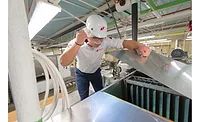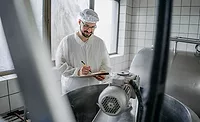One Machine for All Sanitation Procedures

Boosted-Pressure Technology
Boosted-pressure foam cleaning has gained notoriety in Europe and Asia, however, it remains relatively unknown in the U.S. Nonetheless, it is gaining popularity as food facilities begin to replace high-pressure cleaning and tap water pressure cleaning. While high-pressure cleaning, with a pressure of 1500 psi or more, does a good job of removing dirt and food particles, it also slowly deteriorates the contact surfaces it is used on. High-pressure water also damages equipment and requires a lot of labor time to rinse because of the small amount of surface area that can be cleaned at one time. Boosted-pressure rinsing does very well at a lower pressure of approx. 350 psi at 8-13 gpm and it drastically reduces rinsing time, energy and water consumption, and damage to equipment surfaces. Our boosted-pressure systems also significantly reduce bioaerosols that are created by a high-pressure spray. The bioaerosols can linger in the air for up to three hours. Not only do boosted pressure cleaning systems minimize bioaerosols, they also create optimum soil removal, rinsing time, and water reduction. It is widely known in the sanitation industry that rinsing time is, by far, the most time-consuming aspect of the sanitation process. To address this issue we recommend pre-foaming the surfaces with chemical cleaning foam rather than pre-rinsing with water. This softens the dirt and can save up to 40% in overall cleaning time, water and energy.
All-In-One Consolidation
In the food and beverage industry, the open plant sanitation process typically involves three common cleaning steps which are rinsing, foaming and sanitizing. Here in the U.S., many plants are using three different hose stations for these different cleaning steps. Our system combines boosted-pressure rinsing, chemical foaming, and spray sanitizing onto one machine with one hose for application. Designing the system to be all-in-one became possible because of the integrated design of the state-of-the-art chemical mixing unit called the “Foamico Next Block”. To make this easier to imagine, we like to tell customers that this is the same concept as a manual car wash system. It is done simply with one handle to change in between the multiple functions of the system and with one hose for spraying all chemicals and water. Once the handle is turned to the desired function (pressurized rinsing, chemical foaming, or spray sanitizing) the user attaches the colored quick-connect nozzle onto the end of the hose gun. When applying chemical foam the negative pressure generated through the Next Block creates suction which draws the chemical from the chemical jugs below to the cabinet. The chemical is then injected through the Next Block into the out-flowing water along with compressed air to create a high-quality foam. Our system is very versatile and can be used with almost any chemical for food plant sanitation. Since every food processing facility is different and some may have different needs in regards to water volume and foam quality, we have a variety of nozzles, angles, and volumes to fit specific needs. All systems include a full set of color-coded nozzles including one blue rinsing nozzle, one blue rinsing lance, one white foaming nozzle and one yellow sanitizer nozzle.
System Installations
Depending on the size of the sanitation team, various boosted pressure foam cleaning systems and set-ups are available. Our systems are available in four types. Booster Pumps, Main Stations, Satellite Stations, and Mobile Units.
Main Station: A typical Main Station will be adequate for a sanitation crew of 1 to 6 employees. A Main Station has a booster pump to pressurize the tap water from approximately 50 psi to 350 psi and it has a Next Block chemical mixer with a handle to change between the rinsing and cleaning functions. Both are installed inside a stainless steel Main Station cabinet. The Main Station cabinet is mounted to the wall. The outlet hose for spraying is connected at the bottom of the Main Station.
Satellite Unit: The difference between Main Stations and Satellites is that Satellites are only equipped with the Next Block chemical mixer. Satellites are simply powered by the pressurized water that is piped from a Booster Pump or from the pump inside a Main Station for pressurized rinsing. Each Satellite has its own hose for boosted rinsing and applying three different chemicals. The chemical jugs are mounted below the unit. As many as five Satellite Stations can be piped from one Main Station.
Booster Pump: For larger production facilities, the use of a Booster Pump system connecting multiple Satellite Stations allows up to a maximum of 36 simultaneous users. For a failure-free operation, it is important that the water supply is sufficient to the booster pump. This is the main reason for the booster pump to be located in the plant water supply room or in water preparation room. The boosted water gets piped to the Satellites which are installed and distributed throughout the facility about 80-120 feet apart. Each Satellite operates independently and does not require electricity. It only requires the pressurized water from the Booster Pump or Main Station pump to fully function. Booster Pumps are mounted on the floor with a stainless steel floor bracket.
Mobile Unit: Our Mobile Unit operates very similar to a Main Station and is a great system for smaller facilities with a small sanitation crew of one or two people. A Mobile Unit is basically a Main Station on a mobile cart-mounted with a small booster pump to pressurize tap water from 50 psi to a pressure of 350 psi. The Mobile Unit is simply plugged into a tap water source with a flexible 30 ft. inlet hose and an electrical source with a 30 ft. electrical cord. It is also equipped with the Next Block chemical mixer for chemical foaming and sanitizing. The chemical jugs are placed on a rack on the back side of the unit. We have a Mobile Unit for one and two users.
Looking for quick answers on food safety topics?
Try Ask FSM, our new smart AI search tool.
Ask FSM →
Fields of application: Boosted-pressure foam cleaning is suitable for all processing areas in the food industry which are designed for wet cleaning. Floor drains must be present and equipment that needs to be cleaned must be suitable for wet cleaning. Machinery and systems that have sensitive electronic components can also be cleaned with water and foam if the electronics comply with protection classes IP67 or IP68 or if they are covered with a water-repellent cover before the cleaning process.
Since the foam cleaning systems can be used with acids as well as with caustics, all dirt, oils, and mineral scaling can also be removed with the appropriate chemical. Each chemical contained in a jug below the unit has an independent chemical injector which eliminates the risk of concentrated chemicals mixing together. With this integrated system design, all cleaning processes can be carried out with one machine and one hose.
Joseph Lincicum is the technical sales engineer at Sulbana Inc. For more information, visit Sulbana.com or call 608-426-6415.







